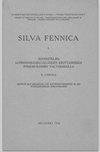Habitat associations of red-listed epiphytic lichens in Finland
IF 1.8
3区 农林科学
Q2 FORESTRY
引用次数: 2
Abstract
The Finnish red list shows that the epiphytic lichen flora of Finnish forests is highly threatened and declining steeply. Red lists provide limited information on the habitat associations of threatened species, which could be relevant in informing management and conservation measures. We used documented empirical data and expert assessments to determine for each red-listed (IUCN categories Near Threatened, NT; Vulnerable, VU; Endangered, EN; Critically Endangered, CR; Regionally Extinct, RE) epiphytic lichen species of Finland the following key habitat associations: host tree species, substrate type, habitat type, geographical distribution, preferred microclimate, and minimum required forest and tree age. The most important host tree species were Picea abies (L.) H. Karst. and Populus tremula L. Other tree species of high importance included Sorbus aucuparia L. and Salix caprea L. One fourth of red-listed epiphytic lichens were primarily lignicolous. Most species required old-growth forests (required by 41% of species) or old trees (52%), but many species required only mature forests (36%) or trees (35%). The microclimatic preferences of most red-listed epiphytic lichens consisted of high or intermediate light availability and humidity. Most species whose status had deteriorated were dependent on deciduous trees. The continuous availability of old deciduous trees (especially Populus, Salix and Sorbus) requires special attention in both managed and protected forests. Red-listed epiphytic lichens would be aided by increased forest protection or transitioning to less intensive management regimes.芬兰红色名单附生地衣的生境关联
芬兰的红色名录显示,芬兰森林的附生地衣植物群受到高度威胁,并急剧减少。红色名录提供了关于受威胁物种栖息地关联的有限信息,这些信息可能与通知管理和保护措施有关。我们使用记录的经验数据和专家评估来确定每个红色名单(IUCN类别近危,NT;脆弱,VU;濒危,;极度濒危;芬兰区域灭绝的附生地衣物种:寄主树种、基质类型、栖息地类型、地理分布、偏好的小气候、最小森林和树龄。主要寄主树种为云杉(Picea abies)。h .岩溶。红皮书附生地衣中,四分之一的地衣以木质为主。大多数物种需要原生林(41%的物种需要)或古树(52%),但许多物种只需要成熟林(36%)或树(35%)。大多数红名单附生地衣的小气候偏好包括高或中等光效度和湿度。大多数状态恶化的物种依赖于落叶乔木。在管理和受保护的森林中,需要特别注意老落叶树(特别是杨树、柳和酢浆草)的持续供应。列入红色名单的附生地衣将得到加强森林保护或过渡到较不密集的管理制度的帮助。
本文章由计算机程序翻译,如有差异,请以英文原文为准。
求助全文
约1分钟内获得全文
求助全文
来源期刊

Silva Fennica
农林科学-林学
CiteScore
3.50
自引率
11.10%
发文量
21
审稿时长
3 months
期刊介绍:
Silva Fennica publishes significant new knowledge on forest sciences. The scope covers research on forestry and forest ecosystems. Silva Fennica aims to increase understanding on forest ecosystems, and sustainable use and conservation of forest resources. Use of forest resources includes all aspects of forestry containing biomass-based and non-timber products, economic and social factors etc.
 求助内容:
求助内容: 应助结果提醒方式:
应助结果提醒方式:


